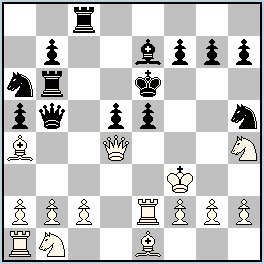 No.528 No.528 Nicolas Dupont (France) |
Original Problems, Julia’s Fairies – 2014 (I): January – April →Previous ; →Next ; →List 2014(I) Please send your original fairy problems to: julia@juliasfairies.com |
No.528 by Nicolas Dupont – A big surprise! The first PG problem with Disparate condition! As all published PG problems it will participate in the Tournament for Retro and PG problems published at Julia’s Fairies in 2013 – 2014. (JV)
Definition:
Disparate: If one side makes a move with a piece of type “x” (black, white, neutral, half-neutral, etc., King included), the other side cannot answer immediately by moving a piece of the same type “x”. (For example: white Qc1, black Ka8,Qa7 – mate in 1 move. After 1.Qc8#, Black is mated because 1…Qb8? is illegal. The mate is possible also with the neutral nQc1 – after 1.nQc8#. Black cannot move the same neutral Queen.) Every Pawn’s promotion is a Pawn’s move, therefore after such promotion (into any possible piece) the other side cannot answer immediately with its Pawn. We can say that after the move of the figure of type “x” any enemy figure of type “x” falls under Half-moving paralysis. This paralysis disappears immediately on the next half-move, if the opponent plays with another piece of type “y”. (This way it is implemented in Popeye. Another implementation of Disparate you can find in WinChloe, but it is based on the different rules. )
|
No.528 Nicolas Dupont
France
original – 16.04.2014
 PG 16 (14+14) C- PG 16 (14+14) C-Disparate Solution: (click to show/hide)
|



An amazing idea and very cleverly composed. It is hard to reach the final position, even if you know what all the moves are! The wPd2 captures on c7 and promotes to Q on c8, and the bBc8 captures on e2. This accounts for all the moves, but if you try to get there it will make you laugh! It is tricky to move a pawn, because the other side can’t move a pawn on its previous or next move. This is why White moves a pawn on move 1, because it is the only time there is no previous move!
I admired at this game the idea and also the technique realization. High class.
Another partial approach to validating this wonderful composition is to run it as an orthodox proof game. Natch 2.5, though old, delivered 50014 solutions in less than 2 minutes. I took these into a spreadsheet, to see whether any avoided illegal moves. None did! So any cook must involve a “non-pin”, normally illegal, where a line unit moves out of the line between its king and an enemy line unit of the same type. The actual solution exhibits this effect twice.